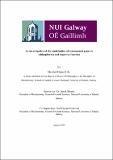| dc.description.abstract | The centrosome is the key microtubule organising centre of animal somatic cells. Centrosomes play a crucial role in brain development, influencing cell shape, polarity, motility, and division. The older of the two barrel-shaped centrioles that form the core around which the pericentriolar material assembles can serve as the base of the primary cilium, an antenna-like structure with sensory and signal transduction functions that are essential for brain development. Mutations that affect ciliary function cause ciliopathies, heterogeneous developmental or degenerative disorders that affect multiple organs, including the brain.
Schizophrenia (SZ) is a chronic psychiatric disorder affecting approximately 1% of the population. Symptoms range from delusional thoughts and hallucinations to anhedonia and social withdrawal. Affected individuals also display cognitive deficits in IQ, memory and attention. Cognitive deficits are a key factor for explaining disability, leading to significant unemployment, homelessness and social isolation. SZ is highly heritable and significant genetic overlap between SZ and cognitive ability means that some genes contribute to both phenotypes. Genome-wide association studies (GWAS) have now identified hundreds of loci for SZ and cognition phenotypes such as human intelligence (IQ) and educational attainment (EA). The molecular mechanisms by which associated genes contribute to SZ risk and cognitive function are not well understood. However, the likelihood is that genetic variation within multiple biological pathways contributes to both illness and lower cognition function.
I have focused on the contribution of the centrosome genes to SZ and cognition. I found that, common variation in centrosome genes are enriched for association with IQ, while rare variants are enriched for association with ID and ASD. The ciliopathy gene SDCCAG8 is associated with SZ and EA and social cognition in our Irish dataset. Genome editing of SDCCAG8 caused defects in primary ciliogenesis and cilium dependent cell signalling. These ciliary defects in the absence of SDCCAG8, I hypothesise are due to impaired protein trafficking to the ciliary transition zone (TZ), a specialised ciliary compartment that forms a gate, controlling protein entry and exit from
the primary cilium. Transcriptomic analysis of SDCCAG8-deficient cells identified differentially expressed genes that are enriched in neurodevelopmental processes such as generation of neurons and synapse organization. These processes are enriched for genes associated with SZ, IQ and EA. Phenotypic analysis of SDCCAG8-deficent neuronal cells revealed impaired migration and neuronal differentiation, which have been implicated in SZ pathogenesis previously. These data implicate ciliary signalling in the aetiology of SZ and cognitive dysfunction. | en_IE |


